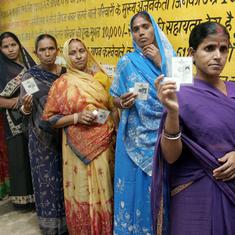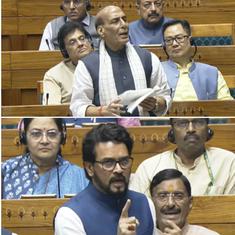Last Monday, Assam Chief Minister Himanta Biswa Sarma announced in the Assembly that the state government plans to invoke a law from 1950 to “push back” more suspected foreigners.
As part of a crackdown on “illegal immigrants” in the state, several people declared non-citizens by Assam’s foreigners tribunals were picked up by the police in the last few weeks and then forced out of Indian territory along the Bangladesh border.
Allegedly, all of them were Muslims of Bengali-origin, a community vilified as illegal immigrants from Bangladesh, though many of its members have been living in Assam from before Independence.
As families clamoured for information of their relatives, some of whom were surfacing in videos shot in the no man’s land between India and Bangladesh, Sarma confirmed that his government was forcing “declared foreigners” out.
In his statement in the Assembly and subsequent declarations, Sarma doubled down, claiming that the expulsion of declared foreigners was justified in the legal framework provided by the Immigrants (Expulsion from Assam) Act, 1950.
Declared foreigners are not undocumented migrants, or those caught trying to enter India, but people who have lived in Assam for decades and claim to be Indians. However, they have failed to convince foreigners tribunals that their ancestors lived in Assam before March 25, 1971 – the cutoff date for foreigners entering Assam to claim Indian citizenship under Section 6A of the Citizenship Act.
Foreigners tribunals are quasi-judicial bodies unique to Assam that decide on citizenship matters.
To buttress his argument, Sarma has also claimed that a Supreme Court judgement from October 2024 upholding Section 6A “has given sweeping powers to the Assam government” to act under the 1950 law and that a deputy commissioner now has the power to evict any person if he finds prime facie evidence of his or her being an “illegal foreigner”.
However, legal experts Scroll spoke to disagreed, arguing that the Assam chief minister was misinterpreting the law and the Supreme Court judgement to justify what is patently illegal.
Sarma’s interpretation “is an over-reading of the judgement in a manner so as to justify a thoroughly illegal exercise”, said Delhi-based advocate on record Fuzail Ahmad Ayyubi, who was involved in the Section 6A case before the Supreme Court. The claim is that “‘push-backs’ are validated by the Supreme Court judgement. That is simply not the case.”
A brief history of the 1950 law
Partition and subsequent communal riots led to a movement of refugees and other migrants into Assam from East Pakistan.
According to a 2012 white paper by the Assam government, around 5 lakh migrants and refugees entered the state in these initial years.
As popular discontent grew about the migration into Assam, the Union government brought in a law – the Immigrants (Expulsion from Assam) Act 1950 – to tackle the presence of alleged foreigners. The law empowered the government to expel “a person or a class of persons”, who were “ordinarily resident outside India and have come into Assam, if it believes their stay “is detrimental to the interests of the general public of India”.
However, the law gave relief to refugees fleeing Pakistan on account of “civil disturbances or fear of such disturbances”, given the context of Partition.
Hiren Gohain, a social scientist and arguably Assam’s foremost public intellectual, pointed out that at the time of the law’s passage, the border between Assam and East Pakistan was only three years old.
“Most people in rural East Pakistan [now Bangladesh] were either unaware of or were not serious about that border,” he told Scroll. “For 80-odd years before 1947, they had been crossing it as often as they liked without any hindrance. They had often been told by their leaders that all the region would soon all be Pakistan.”
The law, he said, was “designed to catch and expel such ‘infiltrators’’.
Between 1962 and 1964, the police began a crackdown on alleged infiltrators. “They did not say that they did it under this act,” said Assam-based advocate Oliullah Laskar. “But this was the only law at that time that could give power to the government.”
Laskar added: “They pushed back mainly Bengali-speaking people, irrespective of religion.”
The drive soon stirred up a storm. “The process of detection and deportation was so atrocious that … Fakhruddin Ali Ahmed, an Asamiya Muslim, who was then finance minister of Assam, and later became Union minister and President of India, had to take up the issue of atrocities and inhuman torture meted out to the innocent Indian Muslim citizens,” wrote political scientist Monirul Hussian in his book Assam Movement: Class, Ideology and Identity.
Ahmed threatened to resign over the harassment of those wrongly accused of being foreigners.
According to the Assam government’s white paper on the foreigners’ issue, Pakistan also threatened to drag the issue of deportation to the United Nations.
Eventually, it was “decided by the Central Government that before eviction every individual case should be examined by judicial authority...to stand the test of scrutiny before the international forum”, the white paper said.
In effect, the contentious implementation of the 1950 law opened the doors to Assam’s most important citizenship determination mechanism – the foreigners tribunals. Four such tribunals were set up by a statutory order on September 23, 1964, and more were to follow.
Legal experts argue that the Himanta Biswa Sarma government, by invoking the 1950 law, was dragging the state back to the days of arbitrary expulsions, without even the “fig leaf” of due process provided by the foreigners tribunals.
What the government is saying is “let’s pick up whoever we think is an illegal migrant and throw them across the border”, said a lawyer who is associated with citizenship litigation at the Gauhati High Court and the Supreme Court. “The state is very clearly saying that it no longer has the patience for due process and it wants to go back to a time of lawlessness, what we saw in 1961 and 1962.”
The Section 6A judgement
To justify his government’s actions of forcing out residents of his state into Bangladesh, Sarma has cited the Supreme Court judgement that upheld Section 6A of the Citizenship Act, 1955.
Section 6A was introduced as a special provision under the act after the Assam Accord was signed between the Union government and leaders of the Assam Movement in 1985. The accord had brought to an end the six-year-long agitation in the state against “illegal infiltration” from Bangladesh.
The Section 6A provision opened up a path for Indian citizenship for those who came to Assam between January 1, 1966, and March 25, 1971. The cut-off date refers to the start of the 1971 Indo-Bangladesh war, which led to the creation of Bangladesh, and resulted in millions of refugees seeking shelter in India.
According to Section 6A, those who entered the state after March 25, 1971 are not eligible for citizenship.
In the operative part of last year’s judgement upholding the validity of this provision, the court had directed that the “provisions of the Immigrants (Expulsion from Assam) Act, 1950 shall also be read into Section 6A and shall be effectively employed for the purpose of identification of illegal immigrants”.
But, according to lawyers involved in the case in the Supreme Court, Sarma is misinterpreting the judgement by using it to justify forced expulsions.
For one, the 1950 act did not figure in any substantive way in the hearings, they argued. This was because the chief justice of India at the time, DY Chandrachud, had at the outset limited the ambit of the case to only whether Section 6A is constitutional.
“There were only passing references made to the 1950 act,” said senior advocate Sanjay Hegde, who had argued in the case. “The Assam government also did not indicate in court that it saw the act as a way to push back alleged foreigners.”
The majority judgement of the Supreme Court, the lawyers pointed out, said that both Section 6A and the 1950 act operated in different spheres.
“The 1950 act would apply to anybody in that short crevice who is not covered under the National Register of Citizens and who has never applied for citizenship through the NRC,” said a lawyer involved in the matter who requested anonymity.
The National Register of Citizens is a list of Indian citizens living in Assam, which was updated between 2013 and 2019 through a rigorous check of ancestral documents in order to identify illegal immigrants who entered the state after March 25, 1971.
Instead, the lawyers argued, Sarma’s invocation of the 1950 act threatens to subvert Section 6A, which the Supreme Court has upheld, as well as the National Register of Citizens.
Sarma has claimed that even persons on the NRC are not exempt from summary “pushbacks” under the 1950 law.
However, the lawyer involved in the Section 6A case pointed out, “Once you apply for the NRC, you are subject to the Citizenship Act and the rules made thereunder. You are not subject to the 1950 Act since you are not an immigrant for the purpose of that act.”
Laskar, the Assam-based advocate, agreed. He pointed out that the preamble to the 1950 Act states that it is aimed at people who entered Assam, and not those who live here. “[It is meant for] the one who was caught while he was illegally entering India or who overstayed his visa,” he said.
Ayyubi, the Delhi-based advocate on record, pointed out that Sarma’s declarations also go against the Centre’s avowals before the Supreme Court.
In 2019, the Union government had made an assurance that people excluded from the National Register of Citizens would not be detained or be made “stateless” or a “foreigner”. They would continue to enjoy rights till they exhaust remedies available under the law to appeal their exclusion before foreigners tribunals set up in Assam for this purpose, Ayyubi said. “Even a person excluded from the NRC has a recourse to appeal,” he said. “The 1950 Act therefore would not apply to persons who had applied and participated in the NRC process.”
Lawyers involved in the case also underlined that the 1950 law could, in any case, not be used to validate “pushbacks”. This was because these exercises were unconstitutional.
The lawyer who requested anonymity said that the 1950 act only empowered the executive to “cause to be removed from the territory of India” foreigners in specific circumstances. Pushing individuals across the border without any hearing and seemingly without any reasoned order did not fulfil the constitutional requirement of natural justice, he said.
“Any procedure established by law should be fair, just and reasonable,” added advocate Aman Wadud. “It cannot be arbitrary like the chief minister wants.”










